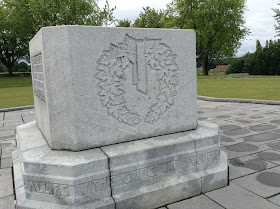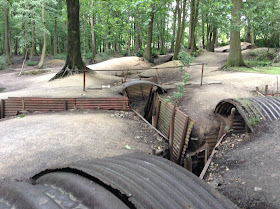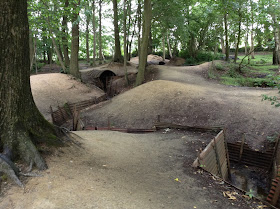I've reproduced the very cool brochure that the museum provides to visitors. I really like the Art Deco-style design of the piece as well as the quaint language. It really has the look and feel of something produced in the late '20s or early '30s, which it very likely was!
LOL at the reference to the "Britisch Battle Fields"...
But before we went into the museum proper, we walked a couple hundred metres up the road to the Canadian Hill 62 memorial.
It's laid out so that visitors can determine the direction of the various villages that comprised the battlefield. The views from the memorial were beautiful and haunting, when you imagine what was going on here nearly 100 years ago.
The interior of the museum has a ton of artifacts but not a lot in the way of curation or explanation. But that's OK too, as long as the stuff is cool, which it was ;-)
Pam is contemplating the massive collection of pickelhauben. As an avid pickelhaube enthusiast, she was happy to see that her favourite state, Mecklenburg-Schwerin, was represented. Just kidding!
Strange pinball machine of unknown provenance.
Some very cool trench signs. I'll have to steal some of these ideas for our trench terrain - especially "DUMP".
Outside the museum is an area that purports to be preserved period trenches. I say "purports to be" because I've read varying accounts on their strict authenticity. Whatever the case, the trench system here is certainly old, and its appearance is generally consistent with what you see in period battlefield photography.
Some rusty battlefield scrap including a broken "toffee-apple" mortar.
Shell craters abound. It had been raining earlier so many were filled with water.
Lots of scrap corrugated iron used to shore up trench walls and provide overhead protection.
Back in the year 2015, cattle were grazing peacefully.
Your correspondent.
There was an underground tunnel that stretched 20 metres or so connecting two trench entrances.
A Scottish schoolmistress with her charges.
Crosses laid by visitors on a splintered stump.
These are German grave markers - most were dated 1914.
Rusty rolls of barbed wire.
More random battlefield detritus. The sheer volume of metal left on the battlefields of the Great War simply beggars imagination.
The museum and grounds are certainly well worth a visit. As I mentioned, the curation left a lot to be desired (and some of the mannequins used to display uniforms bordered on disrespectful), but for a person who knows a little about the Great War, you mainly want to just see artifacts anyway, and the Hill 62 Museum has those aplenty. The preserved trenches are very interesting too. If you go, be sure to check out the stereoscope viewers with tons of period photos. Their subject matter is not for the squeamish, but little about the Great War is.









































Re: the detritus, one of the main things I got from reading "Some Desperate Glory" last year was the immense pile of garbage that they regularly discuss and deal with. That and the school boy frivolity of the "officers".
ReplyDeleteGreat pictures Dallas - I loved the signs, and the pinball table - how strange!
ReplyDelete